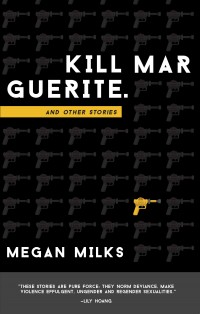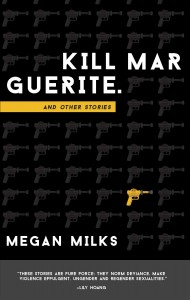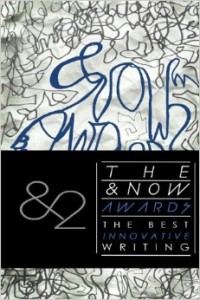Kill Marguerite and Other Stories
 Kill Marguerite and Other Stories
Kill Marguerite and Other Stories
by Megan Milks
Emergency Press, 2014
240 pages / $15.95 buy from Amazon or Powell’s
Rating: 8.5
A few weeks ago I was made vaguely aware of a Flavorwire article about trigger warnings. Later on, as I read Kill Marguerite I found myself writing “trigger warning” in red pen before almost every story in the collection. I know that for many the argument for TWs is to save pain and suffering for those who spend day in and day out struggling to avoid triggering material—it’s just common internet courtesy. I very much respect that, but I’m left thinking about how these warnings prevent the dialogue that the content often necessitates.
April 29th, 2014 / 12:00 pm
Kill Marguerite and Other Stories by Megan Milks
 Kill Marguerite and Other Stories
Kill Marguerite and Other Stories
by Megan Milks
Emergency Press, March 2014
240 pages / $15.95 Buy from Amazon or Powell’s
The possibility of Sweet Valley High twins Jessica and Elizabeth Wakefield having incestuous sister-sex with each other never occurred to me when I was a kid and living for those books, even though half the joy of reading them was a desire for violation when faced with all that phony perfection. I always wanted something sexual or terrible to happen, more than a kiss or someone having her bikini top untied in the pool. (The other half of the appeal was jealousy—oh to be 5’6”, blond, and have sparkling aquamarine eyes and a twin sister! Pulchritude amplified.)
So, I am grateful to author Megan Milks, who in her debut story collection, Kill Marguerite and Other Stories, writes in a letter from Elizabeth to Jessica, “I want to spend the evening watching you get yourself clean. I want to shave my head and lie in bed with you all day long. I want you to tell me you love me more each time you look into my eyes. Tell me I’m what your hands were made for, what your mouth was made for.” It’s hilarious, wonderful, mixed-up, and just how I–and probably all the other dirty-Barbie-players out there–feel about these icons. Do we want to be them, fuck them, destroy them? All at once?
April 28th, 2014 / 10:00 am
The &Now Awards Volume 2: The Best Innovative Writing
 The &Now Awards Volume 2: The Best Innovative Writing
The &Now Awards Volume 2: The Best Innovative Writing
Edited by Davis Schneiderman
&NOW Books, 2012
400 pages / $19.95 Buy from Amazon or Northwestern University Press
The second volume of The &NOW Awards: The Best Innovative Writing is a twin set: one book, two parts, bound together in opposing orientations. There is one side, and then there is an other side. As editor Davis Schneiderman informs us in both introductions, “these ‘sides’ mirror each other, except when they do not.” Craig Dworkin’s “The Cube” on one side mirrors, on the other, a cube-shaped stamp story by Alissa Nutting. Kate Durbin’s appropriative “Anna Nicole Show” corresponds with Joe Atkins’ appropriative “Boxxy Foar 4DD1@!!!!1!!” Visual poetry shows up in the same slot on both sides, Nico Vassilakis’s STARINGS matching up with A.J. Patrick Lisziewicz’s Alphabet Man.
Then there are pieces that don’t (seem to) match at all, but whose correspondence contrives a relationship anyway. The split design comes across as both arbitrary and quite savvy, a description that could easily be applied to the anthology itself—probably to anthologies generally. How does one archive “innovative,” or any category of, writing? Through a book that might as well be two books. Through inverse relationships. Through matches and clashes. There are two sides to innovative writing, the anthology suggests: more than two, obvs, but alas, we must surrender to the limitations of the book.
The &NOW Awards doesn’t purport to claim anything about the “best” innovative writing except that the field is diverse: this is its best feature. It inhabits the “best of” anthology coyly and subversively, and it casts the net far and wide—vastly more so than, say, Houghton Mifflin’s staid Best American Series. The &NOW series is uninterested in genre boundaries, and offers a richly diverse, if necessarily selective, archive of (mostly) US-based contemporary literary writing. Whereas the first &NOW Awards, published in 2009, collected mainly writers who are or have been associated with &NOW as an organization and biennial festival, Volume 2 spreads out more both aesthetically and demographically. This edition includes more writers unassociated with the festival, more poetry, and more variety overall, including several pieces designed to be read on a screen, and, especially welcome, a number of works recently translated into English: for instance, excerpts from three novels written by radical French writer Antoine Volodine (a pseudonym) and two of his heteronyms, translated from the French by Brian Evenson and Antoine Cazé; and an excerpt from Song for his Disappeared Love by Chilean poet Raúl Zurita, originally published in 1985 and translated from the Spanish by Daniel Borzutzky.
The anthology’s dominant mode is arguably appropriation-based writing. Gretchen Henderson opens one side with a metappropriative work: an essay in fragments, On Marvellous Things Heard draws from a selective inventory of literary appropriations of music. On the other side, David Shields opens with an excerpt from Reality Hunger. According to the prefatory statement, &NOW was permitted by Knopf to republish only those parts of the book written by Shields; given that the whole text is a collage of other texts, they republished the Shield’s introduction to the appendix, and the appendix itself, which lists all of the book’s sources. “Who owns the words?” Shields asks. “We do—all of us.” Except we don’t, as Knopf’s restrictions remind us.
These opening pieces foreground concerns central to the anthology overall: issues of authorship, ownership, (un)original writing. The volume is an intertextual feast, or an anti-authority riot, with authors lifting from a broad range of texts, many of them canonical. In her excerpt from The Whiteness of the Foam, Evelyn Reilly amalgamates Moby Dick with a nano-fuel price list and diagrams of synthetic materials to structure a study of literary and environmental immortality. K. Silem Mohammad combines canonical appropriation with web-generated and constraint-based writing in his Sonnagrams, which rework Shakespeare’s sonnets after feeding them line by line into an internet anagram engine. Noncanonical sources show up as well: Kate Durbin chillingly transforms the notorious clown video used in court as evidence against Anna Nicole Smith’s boyfriend and attorney Howard K. Smith; Ken Taylor writes a cento composed of Charlie Sheen quotes (“there are parts of me/ that are dennis hopper”).
October 9th, 2013 / 11:05 am
A Few Things
I think everyone should be as concerned about their art as Lily and her mommy are:
The organizers of The Hunger Games academic conference have released a list of their panels.
Megan Milks’s choose your own adventure book is sweet and sharp. Baby Adolf and Baby Joseph like it as well.
This is an insightful song about girls.
